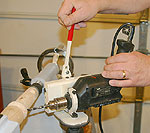 |
The Oneway DrillWizard opens the door to a whole new range of projects on the lathe.
Click image to enlarge |
Oneway DrillWizard
Drilling on the lathe has never been easier
Text & Photos by Tom Hintz
Most lathes have a built-in indexing system that allows positioning the piece for precise and equally spaced drilling. The problem has been how to position a drill, often at an angle on the lathe. The Oneway DrillWizard solves that problem and opens the door to a new set of capabilities at the lathe.
Initial Impressions
The DrillWizard is typical of Oneway products in that it is built from thick steel plating to be sure it is solid and will last a very long time. However, the design is the real key to this lathe accessory. Mounting the DrillWizard in the lathe lets you see the real genius of this tool. While the basic concept of positioning a corded drill accurately may appear simple, the engineering to make it user friendly, accurate and durable were not.
Mounting Base
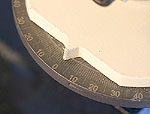 |
The scale on the base is clearly printed, though the markings are small. Bringing in a little extra light helped my 50-something eyes to read them easier.
Click image to enlarge |
The DrillWizard is secured to a 1"-diameter post that fits nearly all lathe banjos (tool rest base). The post is 4"-long, allowing the DrillWizard to be aligned to the spindle centerline on most lathes. A stop collar can be positioned and locked in place with a setscrew so installing the DrillWizard later is fast and simple.
On my Delta 14" lathe the post was actually too long and contacted the banjos locking shaft before I could get it down to the spindle centerline. The post is made from soft steel and was easily shortened with a hacksaw. For most lathes this is not a problem.
The top of the post has a round plate welded to it with a fine degree scale engraved around the edge. A pointer on the drill holder body corresponds to the scale to make setting the desired angle easy.
Drill Holder/Slider
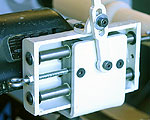 |
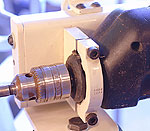 |
(Top) The slider system is ultra smooth and easy to operate.
(Bottom) Most corded drills have the 42mm housing around which the DrillWizard clamps.
Click image to enlarge |
Note: The DrillWizard can be set up for right or left-handed drilling.
The main portion of the DrillWizard houses the plunge mechanism, operating handle and mount for the drill itself. The DrillWizard is designed to work with most corded drills with a 42mm bearing housing behind the chuck. This is a very common configuration, which makes most corded drills compatible. Drill/screwdriver combinations, especially those with clutches are not likely to fit. The good news is that plain, corded drills are very cheap today so permanently equipping the DrillWizard with one, as I did, is not a bank-breaker.
The plunge mechanism is fitted with bronze bushings and glides smoothly on a pair of polished shafts within the housing. Using two shafts helps prevent deflections during drilling.
A 7 1/2"-long handle, measured from the pivot point, controls the forward and back movement of the drill and provides plenty of leverage for drilling with surprisingly large diameter bits.
To control depth a simple but effective eye bolt with a jam nut is threaded into the rear of the housing. The DrillWizard has an overall depth capacity of 2 ¼" but that will be seldom used, making the depth stop a very useful feature. The eyebolt has 20 threads per inch, which makes counting turns (10 turns = ½") to change depth easy.
In the Shop
Using the DrillWizard is surprisingly easy to use once you get the alignment procedure down. Setting up the DrillWizard was more strange than difficult because it is something I haven't done on the lathe before.
 |
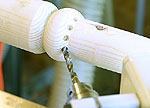 |
Whether drilling straight (Top) or angled holes (Bottom), the DrillWizard makes the job easy and very accurate.
Click images to enlarge |
The main thing to remember is that the banjo (tool rest base) is squared to the lathe bed and the DrillWizard head to the work piece. Once this is done, dial in the angle desired on the scale, lock that down, place the tip of the drill at your mark and square the banjo to the bed.
Mounting the drill requires paying attention because there is no common surface among brands that can be indexed to. Just make sure it is level with and square to the DrillWizard body.
With my old cordless drill installed in the DrillWizard it was time to drill some holes.
The first thing I noticed is how smoothly the slider mechanism operates. Between the smooth-sliding bushings and the 7 1/2"-long operating handle, drilling 1"-diamter holes in hardwood was easier than I expected. The DrillWizard is rigid enough that starting and then drilling 1"-diameter holes in red oak with a Forstner bit at a 20-degree angle is not difficult at all. The holes are clean, true and properly sized because the DrillWizard inhibits wandering of the bit as it enters the wood.
 |
The long handle provides plenty of leverage for working with drills 1"-diameter an larger.
Click image to enlarge |
After drilling the first hole to the depth wanted, set the stop and drilling the remaining holes is fast and accurate.
Once the DrillWizard is set up, the easiest way to drill a bad hole is to index the work to the wrong place. This may seem like a difficult error to make but my lathe has 24 indexing positions, which places the indents rather close to each other. Just "eyeballing" the alignment can get you in trouble. It pays to check that the lathe indexer is in the right position before drilling.
Regardless of the drill size, angle or number of holes to be drilled, the DrillWizard performed flawlessly. It is accurate, tough and needs virtually no maintenance other than keeping it clean.
If there is a down side to the DrillWizard, it is the size of the numbers and hash marks on the scale. For my 50-something eyes the numbers are a bit difficult to read without bringing in a little extra light. This is a small problem and probably relevant only to those who have some level of difficulty reading numbers and scales in general.
Conclusions
The Oneway DrillWizard is a must-have tool for virtually any wood turner. Having the capability to accurately drill holes, straight or angled, opens the door to a large range of projects that would be very difficult without it. Projects like stools are suddenly easy, right down to drilling the angled holes in the legs for the spreaders. The combination of the DrillWizard and lathes the indexer makes it easy to produce perfectly aligned holes every time.
With a street price of $99.99 (4-26-2005) the Oneway DrillWizard is as reasonably priced as it is useful. Its built-like-a-tank construction means the DrillWizard will be a long-term investment.
If you have turning aspirations outside of pens, bowls and peppermills, the DrillWizard will be a welcome addition to your shop.
See the DrillWizard on the Oneway site.
Do you have a comment about this page? - Email Me!
Back to the Tool Reviews List
|
![]()







